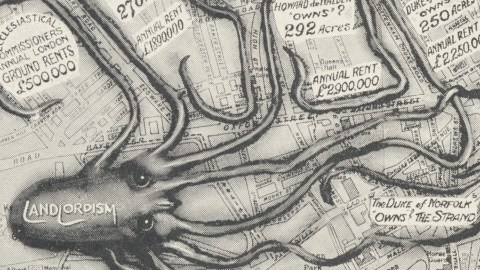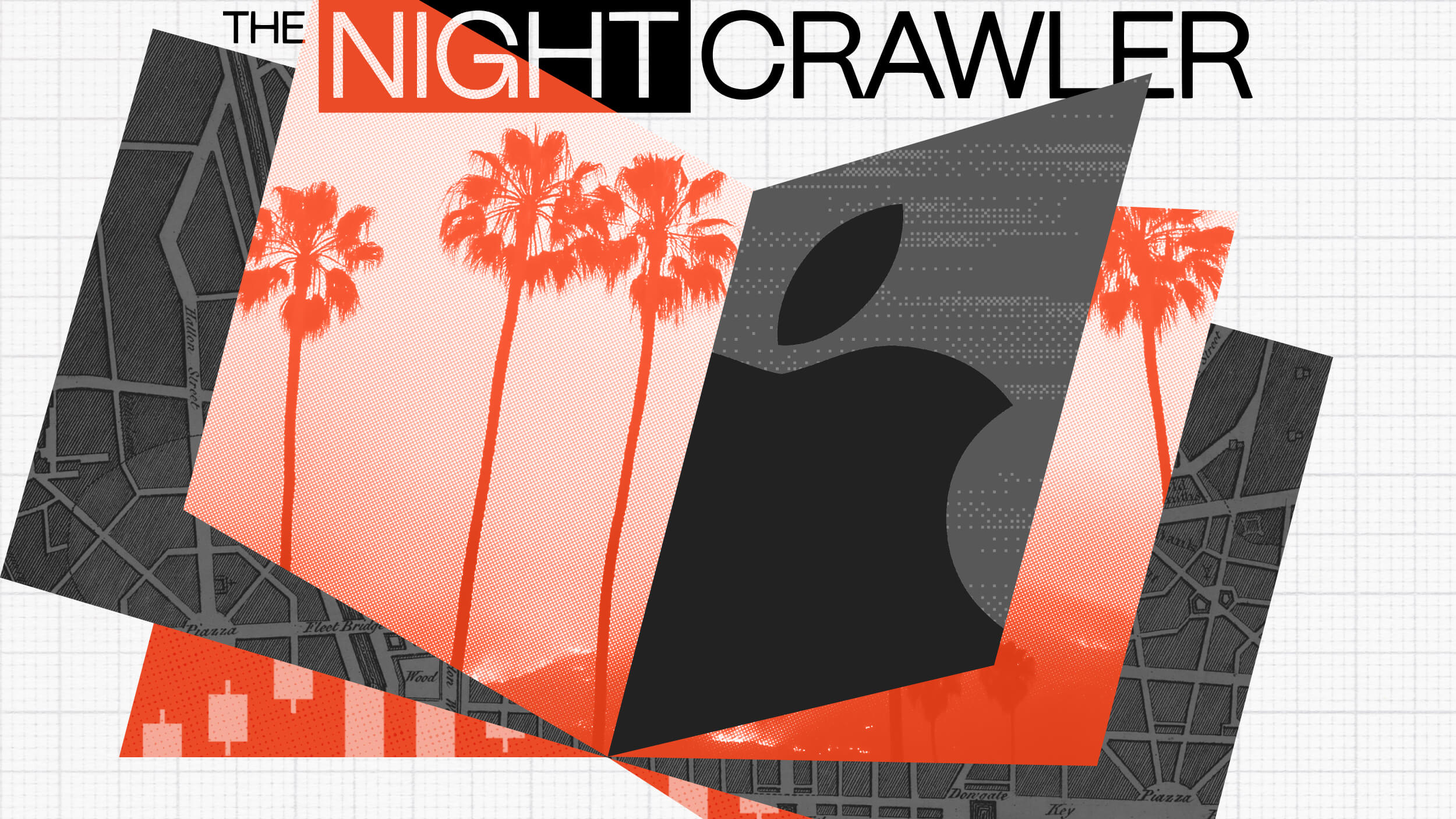The Landlord Octopus, Still Stalking London

The world’s eight richest billionaires own as much as the poorest half of humanity. That’s 3.5 billion people. Oxfam released that figure in January this year, just before the global elite had their annual shindig in the snow at the World Economic Forum in Davos. In the previous year’s press release, it still took 36 billionaires to equal the wealth of the bottom 50%. If wealth concentration continues at this pace, next year it will only take the arm and a leg of a billionaire to own as much as half the world.
By that same logic, the previous years were incrementally egalitarian, and you would only need to go back a few decades to reach Equalhalla, a fabled past of fellowship and sharing. But history doesn’t work like that. Inequality has always existed, and, as this postcard shows, today’s One-Percenters are the Landlords of yesteryear.
The postcard shows a map of central London, attacked by that staple cartographic monster, the Land Octopus – see also #521. On its head is tattooed the term Landlordism, in reality nothing more than a synonym for feudalism, updated for the times – in this case, 1925, the year in which this postcard was published by W.B. Northrop.
By that time, the Middle Ages were long gone, but large parts of London were still owned and exploited by noble families, to the detriment of ordinary folk. As the legend reads:
LANDLORDISM CAUSES UNEMPLOYMENT
It paralyses the BUILDING TRADE;
It Pauperises the Peasantry;
12 Landlords “own” (?) London, taking £20,000,000 a year;
500 Peers “own” (?) an entire one-third of England;
4,000 Landlords “own” (?) an entire half of England;
The Land Octopus Sucks the Lifeblood of the People.

The postcard names a few of the most important London landlords, each one curled up in one of the eight arms of the evil octopus:
Ecclesiastical Commissioners Annual London Rents: £500,000
The Ecclesiastical Commissioners were a corporate body that managed the revenue of the estate of the Church of England. Since 1948, its task has been taken over by the Church Commissioners. They continue to own the freehold of Hyde Park Estate, a residential district in Paddington.
Lord Portman “owns” (?) 270 Acres. Annual Rent: £1,890,000
The Portman Estate got started in 1532, when Sir William Portman, Lord Chief Justice to Henry VIII, acquired the lease of Lileston Manor. Its current London holdings cover an area of about 110 acres (0.45 km2) in Marylebone, from Edgware Road in the west to beyond Baker Street in the east and from almost to Crawford Street in the north to Oxford Street from Marble Arch to Orchard Street in the south.
In total, the Estate spans 68 streets, 650 buildings and four garden squares – Portman Square and Manchester Square the best-known among them. The Portman Estate also owns two farming estates, Portman Burtley in Buckinghamshire and Portman Wilmaston in Herefordshire. The current owner is Christopher Edward Berkeley Portman, 10th Viscount Portman, who inherited the estate in 1999 and has an estimated personal fortune of around £1.2 billion. Apart from the Portman Estate, he also owns property in New York and Florida.
Howard de Walden “owns” (?) 292 Acres. Annual Rent: £2,900,000
In recognition for his role in defeating the Spanish Armada in 1588, Admiral Lord Thomas Howard was created a baron by Queen Elizabeth I. The baronetcy survives, but not in the original family. The current holder of the title is Mary Hazel Caridwen Czernin, baroness Howard de Walden. Her son, Peter Joseph Czernin (born 1966) is the heir apparent. With a fortune or around £4 billion, the Howard de Waldens are one of the richest families in the UK.
The Howard de Walden Estate owns, manages and leases around 92 acres of property in Marylebone, from Portland Place in the east to Marylebone High Street in the west and from Marylebone Road in the north to Wigmore Street in the south. The Estate includes Harley Street, famous for its medical practices, and the hip shopping area of Marylebone High Street.
Duke of Bedford “owns” (?) 250 Acres. Annual Rent: £2,250,000
Originally centred on Covent Garden, the Bedford Estate expanded into Bloomsbury in the late 17th century and sold the original property in the early 20th century. It is still the largest private land-owner in Bloomsbury.
The current, 15th Duke of Bedford is 54-year-old Andrew Russell, who was styled Lord Howland until his grandfather died in 2002, when he adopted the title Marquess of Tavistock. He inherited the ducal title a year later, following the death of his father. His Grace – as he is addressed – is a direct descendant of Mary, sister of Anne Boleyn, the second wife of Henry VIII and mother of Elizabeth I who was beheaded in 1536. His wealth is estimated at over half a billion pounds.
Lord Northampton “owns” (?) 260 Acres. Annual Rent: £1,600,000
The title of Marquess of Northampton is mainly associated with the Compton family, which descends from Sir Henry Compton, who was one of the peers at the trial of Mary, Queen of Scots. Down the generations, the family also included a President of the Royal Society, an Admiral in the Royal Navy, several Members of Parliament, two Bishops, a Prime Minister.
The Compton family are major landowners in Northamptonshire and Warwickshire, and currently still have substantial holdings in London, including in Clerkenwell and Canonbury. They own, among other things, the 16th-century Canonbury Tower, at various times the residence of Thomas Cromwell, Francis Bacon and Oliver Goldsmith.
The Duke of Norfolk “owns” (?) The Strand. Annual Rent: £1,500,000
A title first created by Richard II in 1397, the Duke of Norfolk is the premier Duke in the peerage of England, as well as the Earl Marshal of England, whose duties include the State Opening of Parliament, and who is one of only two hereditary peers granted automatic admittance to the House of Lords. He holds several subsidiary titles, including those of Earl of Arundel and Baron Howard of Glossop. All Dukes of Norfolk are descendants of Edward I. Historically Catholic, some previous Dukes have been imprisoned and even executed for treason.
The current Duke of Norfolk is Edward Fitzalan-Howard, 18th Duke of Norfolk. One of the ancestors of the present Duke of Norfolk had the good sense to acquire a tract of land extending from the Strand to the Thames, which was the source of much of the family’s wealth. That property had since shrunk to about ten acres by the turn of the millennium.
The Duke of Westminster “owns” (?) 400 Acres. Annual Rent: £3,000,000
In 1677, the Grosvenor family acquired about 300 acres of rural land outside the bounds of 17th-century London. Over the centuries, they developed and today still own large parts of Mayfair and Belgravia – prime locations at the centre of the metropolis. These holdings have allowed the Grosvenors to acquire great wealth, and a title to go with it.
The current, 7th Duke of Westminster is 25-year-old Hugh Richard Louis Grosvenor, who inherited the title in August 2016. He is worth well over £10 billion, making him the world’s richest under-30, as well as the wealthiest landlord in London, and one of the richest men in the UK. A very private person, the Duke nonetheless captured some headlines when he was named godfather of Prince George, the first child of Prince William and Princess Kate, and third in line to the British throne.
Earl Cadogan “owns” (?) 200 Acres. Annual Rent: £1,500,000
The Cadogan Estate started in 1712 with the acquisition of Chelsea Manor by Sir Hans Sloane, the famous collector and physician. Via marriage, it came into the Cadogan family. The Cadogan Estate is the main landlord in Knightsbridge and Chelsea, especially around Cadogan Square, Sloane Street and Kings Road. The Estate also owns the Duke of York Barracks, presently housing the Saatchi Gallery, among others.
The Estate is the second-largest in London after that of the Duke of Westminster, and the Earl of Cadogan is also the second-richest landowner in London, after said Duke. The current, 8th Earl is Charles Cadogan, 79 years old. The Earl is a first cousin of the Aga Khan IV, was a lieutenant in the Coldstream Guards, chairman of Chelsea Football Club, and Governor of a school in Suffolk. His heir, Edward Charles Cadogan, holds the title Viscount Chelsea until his accession – similar to the subsidiary title of Prince of Wales for the heir apparent to the British throne.
A legend in the bottom right corner of the map reads:
Octopium Landlordicuss – Common London Landlord. This FISHY CREATURE lives on RENT. Its Tentacles grasp 5 Square Miles of LONDON. This ABSORBENT PARASITE sucks 20,000,000 a year from its VICTIMS – giving NOTHING in return. The People must destroy IT… or be destroyed.
Nothing of the sort has happened. Time chips away at some of these estates, but others grow and prosper. This map, from 2013, shows the main Estates currently still owning large parts of London, of which the reader will recognise more than a few.

The invective postcard by William Bacot Northrop, an obscure crusader for social justice, otherwise only known as the co-author of a book titled The Insolence of Office: The Story of the Seabury Investigations, does not mention two estates presented on the more recent map: the City of London Estate, which owns property both inside and out the limits of its Corporation, and the Crown Estate.
When William the Conqueror took possession of England in 1066, he did so literally – laying claim to the ownership of the entire country, and to its revenues. Those crown possessions have gradually diminished through the centuries, but until the reign of George III, the monarch paid for public and private expenditures from the returns of his domains. Though nominally still the property of the Queen, the Crown Estate today is much smaller, run independently, and its revenues go directly to the Treasury. In exchange, Parliament affords the Royal Family a 15% share of the net revenue.
Much of that revenue comes from the Crown Estate’s London properties, which include the entirety or Regent Street and half of St James’s. It also controls large tracts of farmland and forests, and owns more than half the UK’s foreshore and most of the seabed to the 12-nautical-mile limit, grants licenses for salmon fishing in many Scottish rivers, owns golf clubs, Ascot racecourse, and co-owns several shopping centres.
Clearly, Landlordism is alive and well in the UK, and boasts quite a few more tentacles than shown on Mr. Northrop’s map.
First map found here at Altea Gallery in London, which is offering a copy of the postcard for sale. Second map found here at The Economist.
Strange Maps #820
Got a strange map? Let me know at strangemaps@gmail.com.





